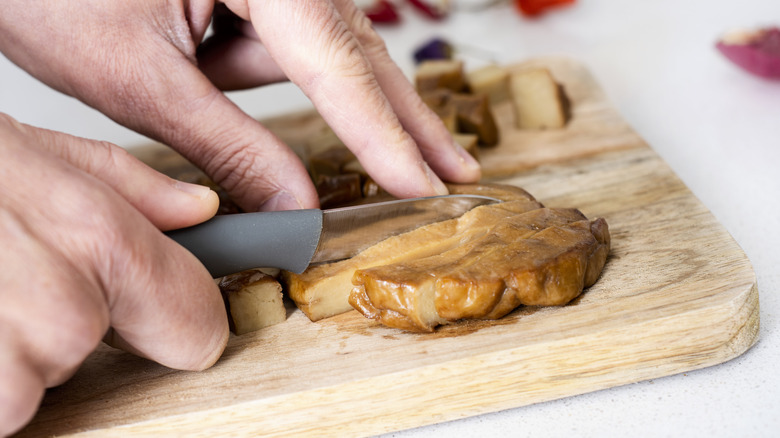What Is Seitan And How Is It Different From Tempeh?
When it comes to plant-based protein, there is no shortage of variety. The market is well saturated with fancy plant-based burgers and vegetarians, but you still cannot go wrong with good old-fashioned soybean-based tempeh or wheat-based seitan. If you are unfamiliar with seitan or "wheat meat," it is definitely worthy of a spot in your plant protein rotation.
For any eaters who are not well-versed in the peculiar world of plant-based proteins, it can be tricky distinguishing between tempeh and seitan. Both are significant protein sources with origins in East Asia, but their similarities stop there. Tempeh is a fermented soybean cake with a flavor many describe as nutty and earthy. It can make a suitable meat replacement with the proper preparation and a little imagination. Seitan, on the other hand, is a wheat-based food that more closely resembles meat texture-wise (and taste-wise, depending on how you prepare it).
The story behind seitan
Seitan gained traction in Western cuisines in the 1970s, around the same time veganism and vegetarianism were on the rise. However, its roots can be traced back to China in the sixth century, specifically in Buddhist monasteries. Since the monks stuck to a vegetarian diet, they sought protein sources from plant foods, including wheat.
They discovered that repeatedly washing wheat dough eliminated the starch and left only the gluten or "wheat protein," which turned it into a chewy, meaty, protein-rich meal. As Buddhism spread to Japan, the recipe for this wheat-based meat alternative did, too. The name seitan was even coined in Japan.
Despite its centuries-long life in East Asia and decades-long life in the West, seitan has skyrocketed into a global phenomenon in the 2020s thanks to TikTok. In 2021, many creators, like Priya Sharma, made videos demonstrating the seitan-making process, captivating audiences by showing how they could turn all-purpose flour into 'meat.'
@himynameispriya Not just hype #seitan
♬ original sound – Priya Sharma
Advertisement
Sharma walks viewers through the rinsing method and how she prepares the dough before and during cooking, noting that adding spices beforehand is key, as it allows the dough to absorb more flavors.
How seitan stacks up against tempeh
Tempeh, like tofu is made completely from soybeans and packs a significant amount of protein. There are several pre-packaged styles available (that require much less work than the seitan) you can cook up for a delicious, satisfying meal. TikTok creator @cookingforpeanuts browns up a beautiful batch of the Lightlife brand version that "she hates to say" tastes just like chicken.
@cookingforpeanuts ☺️You need to start loving Tempeh!! Why? It might very well be the most healthy plant-based high-protein ingredient!!! With 18 grams protein per serving, it's low in calories and a fermented food! It's also a source of iron and calcium! This cooking method combines dry heat and moist heat to both tenderize and season, as well as crisp up the tempeh! Add to salads, grain bowls, or add your favorite marinade and serve with a grain. So delicious! Ingredients: Tempeh Olive or avocado oil Salt Water or broth Garlic powder Paprika 🔗For the full recipe visit cookingforpeanuts dot com or use the 🔗 at the top in my pro file. #tempeh #crispytempeh #veganrecipes #easyveganrecipes #plantbasedprotein #nutritionist #highproteinvegan
Advertisement♬ Great Fairy's Fountain (From "The Legend of Zelda Ocarina of Time") [LoFi Version] – Collosia
Seitan and tempeh are both tasty and affordable plant-based proteins, but each comes with particular drawbacks. Because seitan is pure wheat gluten, it is automatically out the window for those with Celiac disease or other forms of gluten intolerance. Similarly, those with soy allergies should avoid tempeh, as it is made completely from soybeans.
Seitan is also an incomplete protein source, while tempeh offers all nine essential amino acids. The idea of combining proteins in a meal to obtain all those essential amino acids is basically a myth, but if you go the seitan route, it is best to seek other protein sources throughout the day if not in the same meal.
When choosing between seitan and tempeh, it is also best to reflect on what you're craving. If you prefer a plant protein that more closely resembles meat in terms of texture, seitan is the way to go, whereas tempeh's texture is more akin to tofu. No matter which plant food you prefer, you can rest assured that you will not need meat to meet your protein needs.


